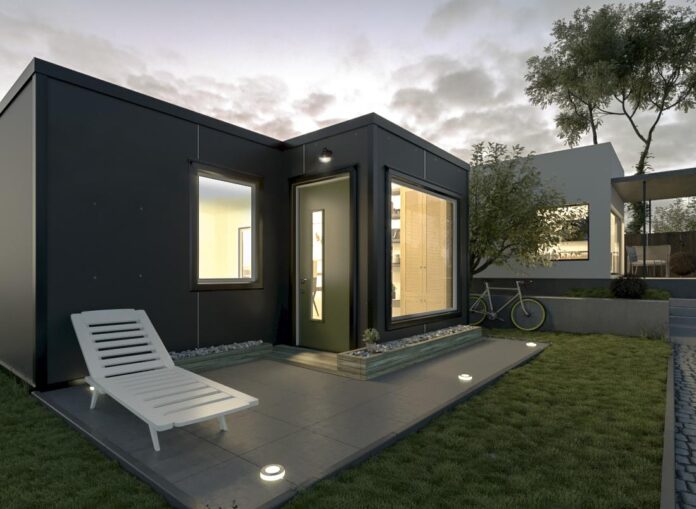Although new regulations forced this modular builder to pivot its business, it still offers affordable, healthy and durable homes
by Stacey Freed
indieDwell’s story shows how a company can pivot to meet changing market conditions without losing their core focus
The original business was affordable modular homes and apartments made from shipping containers
When code changes raised the cost too much, they switched to steel-framed modular construction
Recent decades in homebuilding have been a roller coaster thanks to economic uncertainty, a pandemic and labor and material shortages. This has forced many businesses to be nimble and flexible. That nimbleness includes knowing when to reposition the company.
In 2016, Peter Gombert and his business partner at the time, Scott Flynn, began building houses with shipping containers. Three years later they pivoted to manufacturing cold-form steel volumetric modular components for use in subdivisions and in multifamily housing. Reengineering the company was the right move at the right time but didn’t come without challenges.
Mission Driven
A software entrepreneur for over 20 years, Gombert had been heading up a company called GoodWell, which helps companies analyze workforce data to improve their employees’ wellbeing. Then he connected with Scott Flynn, a GoodWell client and longtime sustainable homebuilder.
Gombert and Flynn both saw an opportunity to create homes that would offer better health for their inhabitants, improve the environment and empower the community — and to do it via a socially-conscious business model that would inspire others. No small feat.
To fulfill their mission, they started indieDwell in 2016. They knew that to achieve their goals they would have to have to build off-site, which they saw as the only way to manage costs and introduce innovation into the building process.
Photo Credit: indieDwell
The first step in their off-site journey was shipping containers. “We fell in love with shipping containers,” says Gombert. “But we wanted to use them in a way that didn’t expose them to the elements.” They also had to address the fact that metal containers aren’t energy-efficient. The solution was a patented wall assembly that sandwiched the shipping container’s metal walls between interior and exterior rigid insulation.
They leased their first factory in Boise, Idaho, and began building units for single-family homes and commercial and multi-family apartment buildings. Then they opened a second factory in Pueblo, Colorado just as the Covid-19 pandemic began. They purchased shipping containers from large shipping companies like Triton. “From a sustainability perspective,” Gombert says, “you’ve got 9000 pounds of steel that would otherwise be heading to the waste stream. We could upcycle it to a home that would last a hundred years.”
According to Gombert, the container homes were designed to look like “any other house.” They were built to the International Residential or International Building Code, and are available as everything from permanent supportive to workforce housing.
The homes also had to reflect Gombert and Flynn’s building principles: durable, healthy, energy-efficient and sustainable. “If you build housing that benefits the occupant, you have the potential for lower cost deferred maintenance over time,” he says. “If the home is energy efficient the occupants will have lower utility bills.”
Student dorm project at The College of Idaho Photo Credit: indieDwell
They built hundreds of units in California, Idaho and Colorado for non-profit developers using government and private funding. Three of their multi-family projects are permanent, supportive housing. Those projects followed the Housing First model, in which those facing homelessness are housed in a permanent setting and offered wrap-around services to stabilize their lives. This puts people in a position where they might eventually secure employment and independent housing.
Regulation and Change
A little more than two years into the venture, the International Code Council began regulating the use of repurposed shipping containers. “Many states, including California, mandated that if you were using a shipping container it had to be new,” says Gombert. That would raise costs.
In addition, Gombert and Flynn took a hard look at the difficulties of working with containers: they are inconsistent in dimensioning; their structural strength makes them difficult to penetrate for utility services; many municipalities don’t know how to permit them, and mortgage lenders and insurance companies have difficulty dealing with shipping containers as a housing structure.
Modules for this building have steel, rather than wood framing. Photo Credit: indieDwell
Then “we ran into Covid-19,” Gombert says. “It was actually fortuitous.” The pandemic gave them time to look for a new building methodology, and they ended up focusing on modules made from cold-formed steel. “It would give us the same structural integrity but would provide a great deal more flexibility.” And unlike shipping containers, cold-form steel modules could be built to whatever dimensions the company wanted as long as they could still ship them.
Why not use wood framing as most modular builders do? “It’s harder to use wood for multifamily infill projects, which is the lion’s share of what we do. With steel we can build higher than what wood would allow,” Gombert says. “If we had to cap out at five stories using wood, we couldn’t [afford to build] the projects we’re doing.” While he acknowledges the debate over which is more sustainable, wood or steel, the company does use partially recycled metal.
indieDwell’s current product is a volumetric module that gets stacked atop other modules and cladded with siding or stucco to make it look like the surrounding homes and buildings. The company has a standard library of products but also works with third-party architects on designs. Modules are built in a 100,000-square-foot factory in Pueblo, Colo. The Boise, Idaho factory location was too small for production, but Boise is still the headquarters for architecture, engineering and back-office work.
At the time of the transition, there were 60 employees in Pueblo and 20 in Boise. There are now 105 in Pueblo and the same number in Boise. “Everyone stayed on,” Gombert says. The transition from containers to steel framing didn’t require the factory to be retooled.
Today, indieDwell produces between 600 and 800 modules per year and ships them to clients in Colorado, California and Idaho. This year they will also venture into Oregon and will be opening an East Coast factory to serve Maryland and Virginia.
All through the change, they did not lose sight of their principles. “Because we’re a public benefit corp. and certified B corp., one goal is to really keep our factories human-powered to create jobs, job training and workforce development. We don’t have a lot of robotics built into the system,” Gombert says.
Because it uses steel construction, indieDwell has more need for welders than other modular companies. Photo Credit: indieDwell
The current business is not any more profitable than the previous business and indieDwell’s margins didn’t change, Gombert says. But pricing has changed because of pandemic-induced supply chain constraints and massive price spikes over the past two years.
Proceed with Caution
Overall, Gombert is happy with the switch and sees modular as a better way to build. However, he also says that going modular is “a lot harder than you would intuitively think.” Some of the issues he points to are outside an owner’s control: supply chain issues, state-building permits, financing and differing building codes in various municipalities.
What is in the owner’s control is the factory itself, but making a factory work is also a complex task. “All the inputs have to come together. To have a good day in a modular factory you have to have a lot of things go right and almost nothing go wrong,” he says. “If staff doesn’t show or materials don’t show, or you don’t have a permit on time, or your drawings aren’t complete, your factory can’t move. Once that happens, you create inefficiency. If the process is out of sync, you have to work super hard to get it back.”
Stacey Freed is a freelance writer and editor based in Pittsford, New York. She focuses on construction, remodeling, real estate, sustainability and wellness.
Photos courtesy indieDwell unless otherwise noted.






